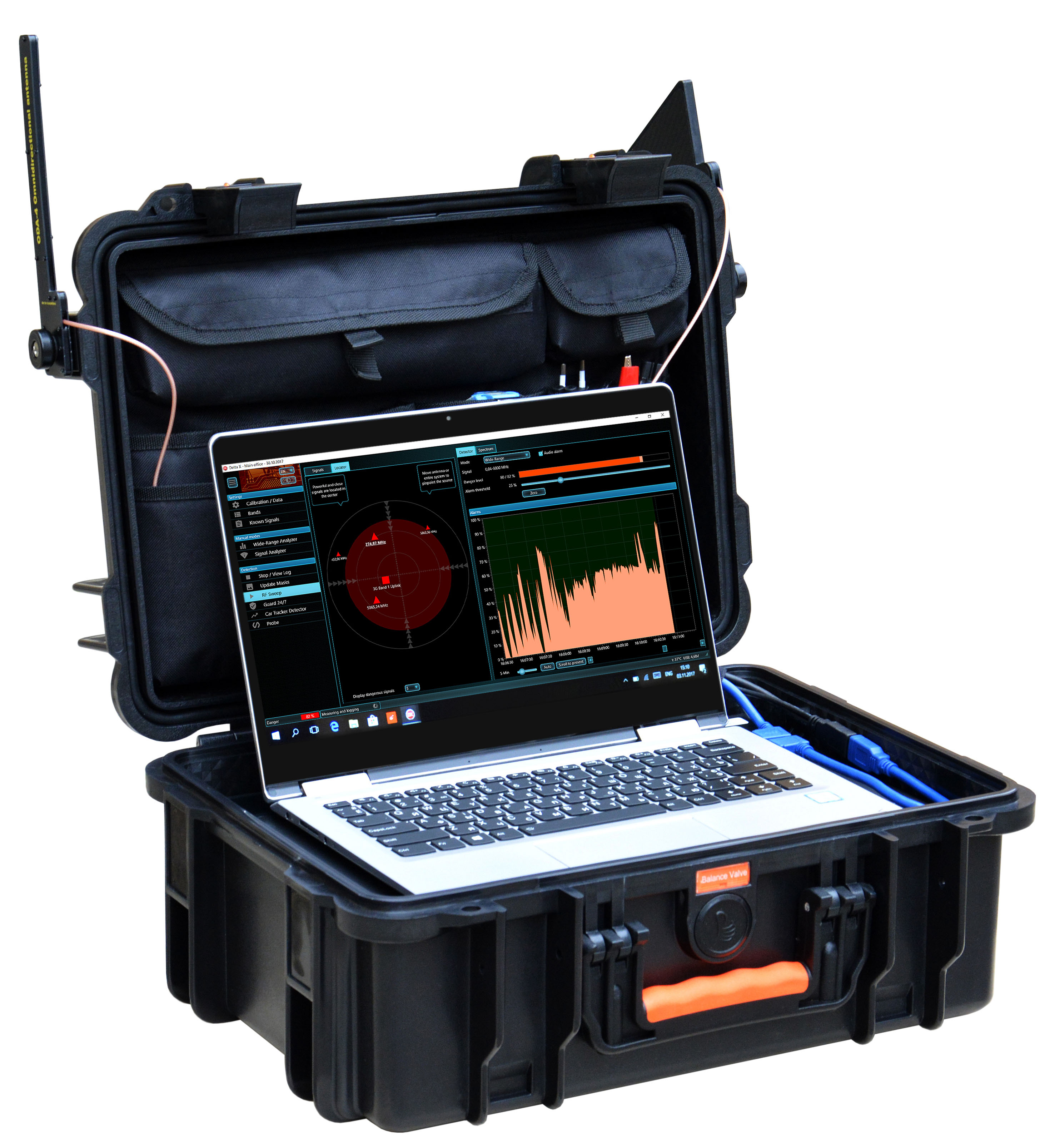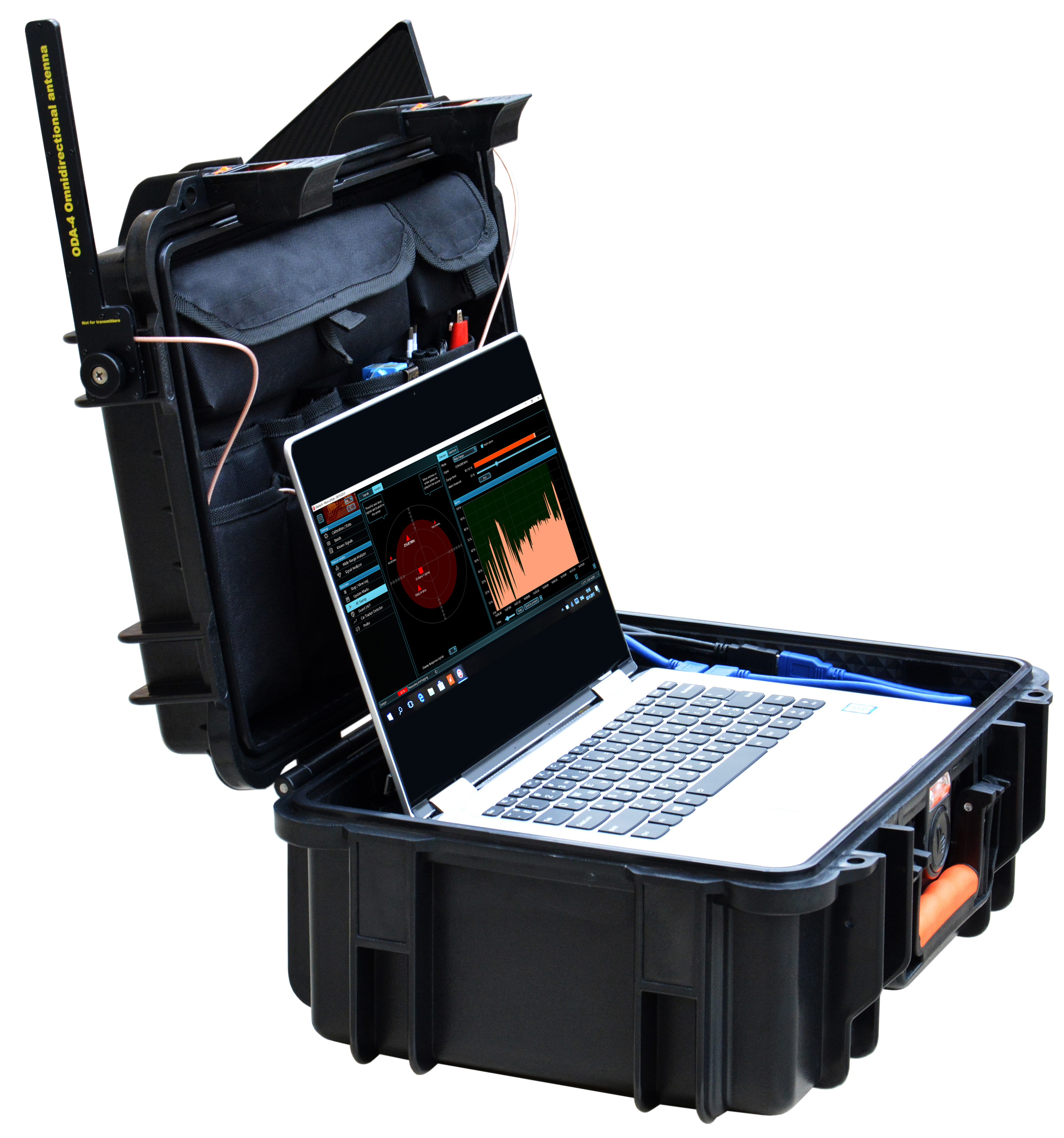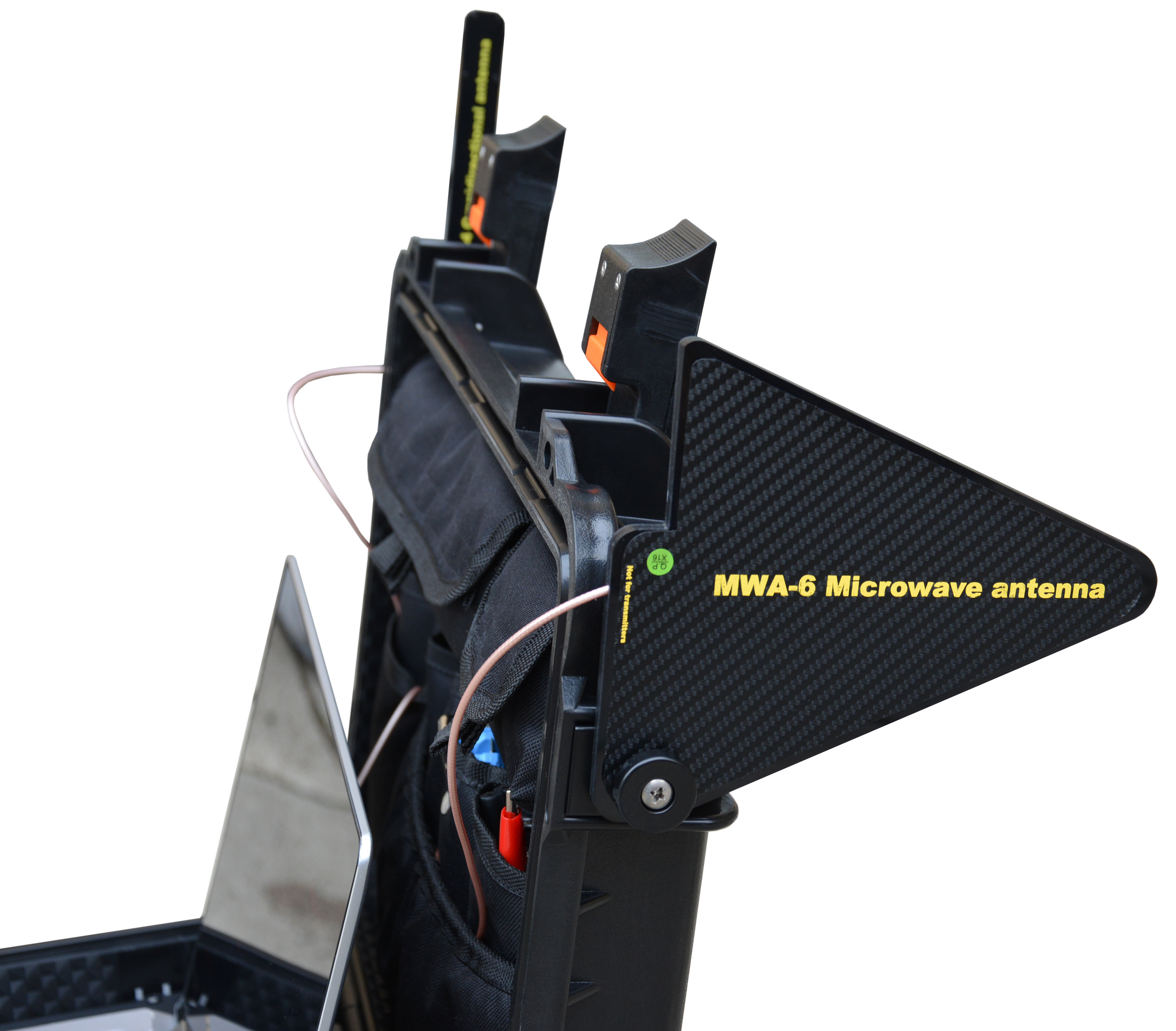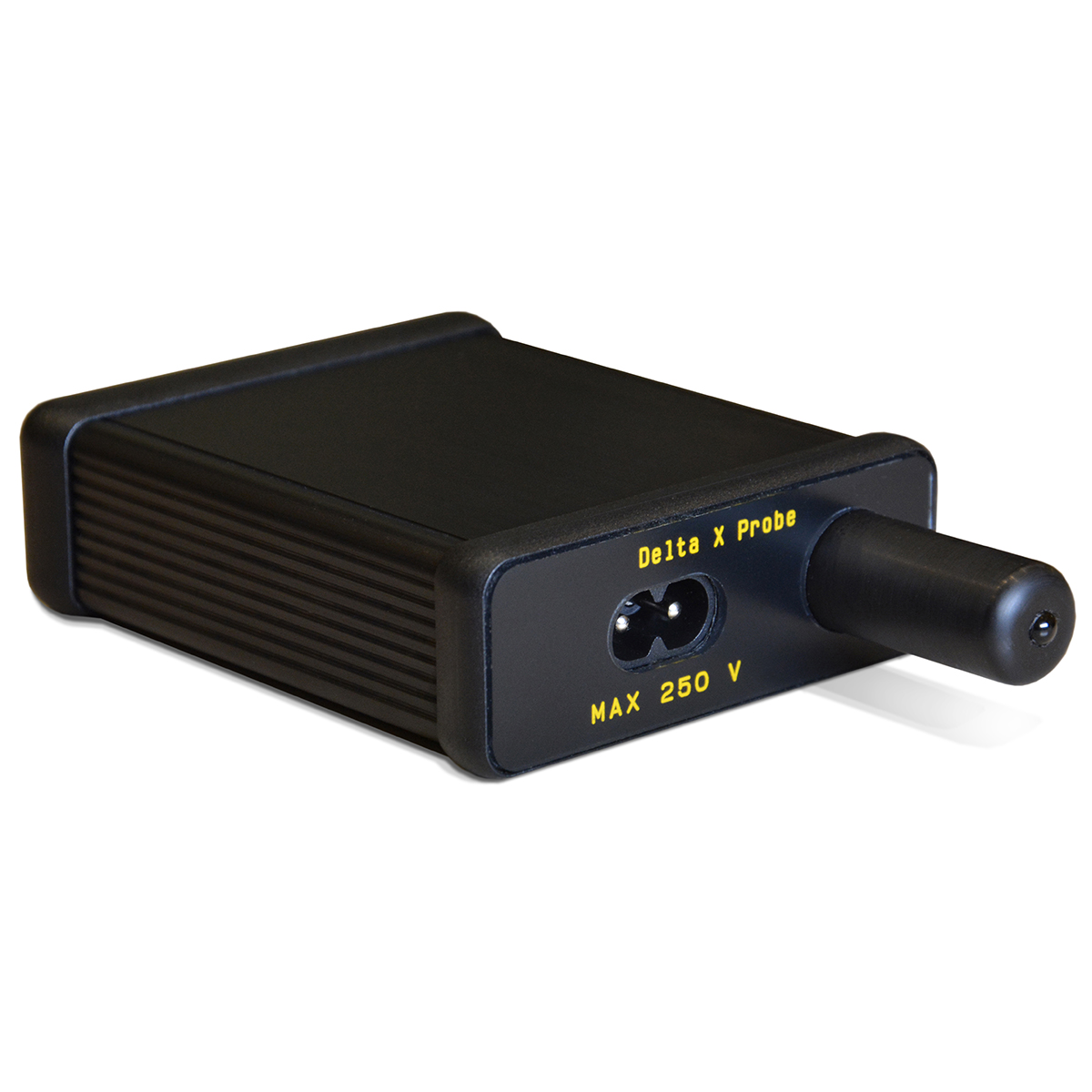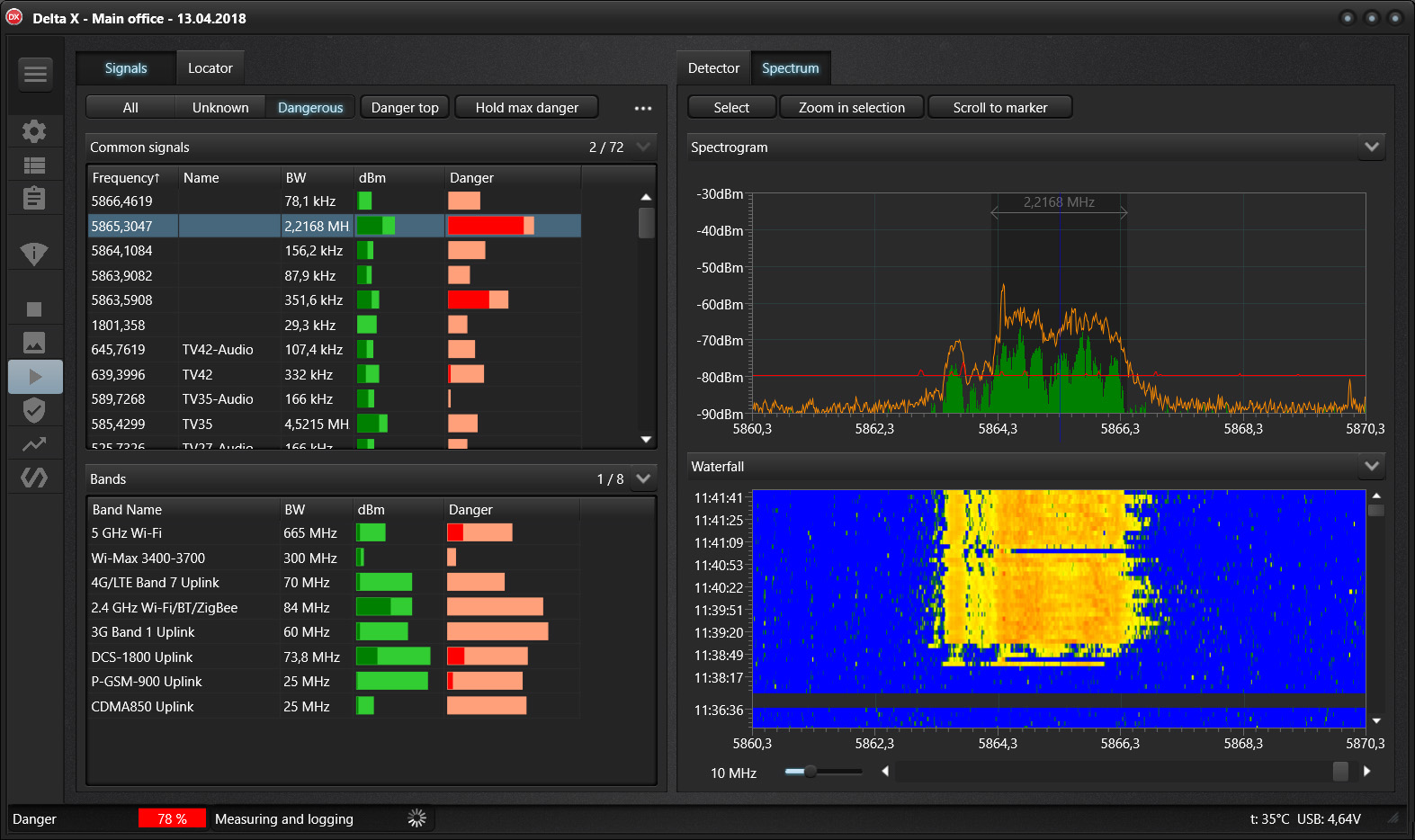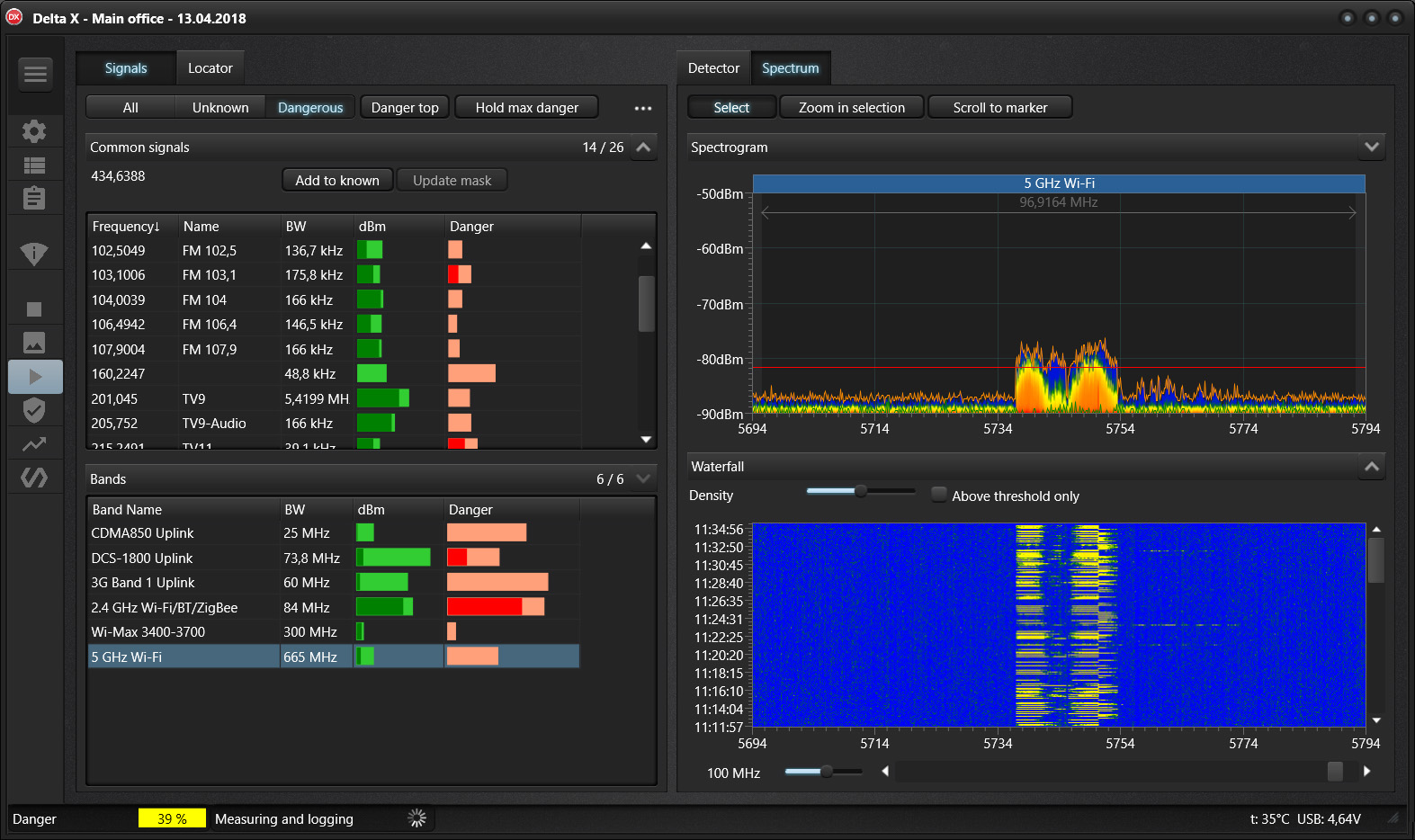Delta X 2000/6 Real-Time
- High update rate, 2000-3000 MHz per second
- Frequency range 9 kHz – 6000 MHz
- Reaction (detection) time: 2-3 seconds
- Instantly detects digital signals with short bursts
- Can detect and locate the transmitter simultaneously
Features
- High update rate, 2000-3000 MHz per second
- Frequency range 9 kHz – 6000 MHz
- Reaction (detection) time: 2-3 seconds
- Instantly detects digital signals with short bursts
- Can detect and locate the transmitter simultaneously
- Quickly and reliably detects all kinds of RF listening devices, including analog, digital, constantly existing and intermittent, sending audio or video, with or without encryptionn
- Finds hidden surveillance devices employing the digital standards GSM, 3G, 4G/LTE, 5G(<6GHz), Bluetooth, Wi-Fi, DECT, etc.
- Detects illegal information transmission in AC, telephone, Ethernet, alarm and other wires as well as in the infrared range with the help of the supplied Multifunction Probe
- Can work in instant detection mode, guarding mode, locating mode and car tracker detection
- Has a 20-50 times higher sensitivity and detection distance compared to conventional RF detectors and near-field receivers
- Can monitor the RF environment 24 hours a day with data logging
- Capable of detecting covert bugging devices with an accumulation function and transmitters hidden within the spectrums of other signals
- Supports storage of an unlimited quantity of signals. Full information is stored in the log and can be reviewed during the detection, or at a later time. Multiple logs are supported
- Demodulation of audio in FM, AM, USB, LSB, CW (adjustable BW 3…240 kHz)
- Alarm relay output can activate external devices when a dangerous signal is detected (turn on a CCTV system, for example)
- Comes in a protected case that allows you to place a 13-14” laptop inside (not included in the supplied set)
- Powered from the laptop’s USB
New features available in the latest updates
- Updated “Alarms” graph can now render two graphs simultaneously: general alarms, and the signal’s alarms.
- The Generate Reportfeature allows the operator to export the results of detection into a PDF file. The report fully describes the RF environment in the monitored zone by listing dangerous and non-dangerous signals and shows their activity in graphs “Alarms”, “Spectrogram”, “Waterfall” and “Persistence”. Example of report
- Sending alerts by email makes it possible to send notifications about detecting dangerous signals. The alerting message will contain information about the detected signals in the attached PDF report.
- The “Check for updates” button has been added. It can check if a newer version is available and download it.
- Remote access from Windows, iOS or Android. The method of remote access is described now.
Detailed description of new features
Advantages
| ✦ | What it is: a portable system controlled by a laptop computer |
| - The high capacity of a laptop’s hard drive enables full data logging during the detection (24/7 possible)
- Wider screen is more convenient for analysis
- Compatible with touch screen laptops
- The handheld use of antennas is more convenient for locating transmitters in hard to access places
|
| ✦ | Handling of the mobile and wireless bands GSM, CDMA, 3G, 4G/LTE, 5G(<6GHz), DECT, Wi-Fi, Bluetooth, etc. |
| - Mobile and wireless signals are detected simultaneously with analog transmissions
- Mobile/wireless signals are detected with the use of individual thresholds and are displayed separately from other signals
- Activities within each band are stored as one signal with a certain danger level to avoid excessive records in the Signals table and to locate the sources with a hopping frequency
- Additional sweepings on the ‘short-burst’ bands are performed to increase the probability of interception of such signals as GSM, 3G, 4G, 5G(<6GHz), DECT, Wi-Fi, Bluetooth, etc.
- External interference from neighboring mobile phones and Wi-Fi routers can be rejected with the help of the thresholds
- The supplied data files allow the operator to adjust the system to the mobile/wireless bands employed in the country of use
|
| ✦ | Sensitivity and detection distance |
| - The built-in spectrum analyzer has 20-50 times higher sensitivity and detection distance compared to conventional RF detectors and near-field receivers
- Resistant to interference – sensitivity remains high regardless of the proximity to wireless routers, cordless phones, mobile phones, TV towers, radio broadcasting and mobile communications
|
| ✦ | Support of the ‘Known signals’ table |
| - The operator can easily distinguish between safe and dangerous signals
- The TV frequencies employed in the country of use can be quickly imported from the supplied data files
- The FM, VHF/UHF police and municipal channels can be collected and stored for further use
|
| ✦ | Advanced signal recognition method |
| - The signals are automatically recognized in the spectrum traces and inserted or updated in the Signals table
- Both analogue and digital signals are captured with an assigning of a corresponding Danger level
|
| ✦ | Unique algorithm of measuring the signal’s Danger level |
| - Uses a combination of the reference trace and individual thresholds for mobile/wireless bands
- Takes into consideration both the signal’s strength and bandwidth
- Works for both analogue and digital signals including transmissions with a changing frequency
- Is used during the locating procedure and provides more reliable results compared to the traditional ‘signal strength’ method
|
| ✦ | Low demands on the operator’s level of knowledge |
| - The system can be prepared for detection with the help of the ‘Update Masks’ procedure within a few minutes
- Manual handing of spectrum traces is not necessary
- Everything is done automatically after the detection starts
- The operator is warned by an audio alarm when a dangerous signal is detected
|
| ✦ | Data logging |
| - All the spectrum traces and alarms are logged during detection
- The situation at any given time can be reviewed and studied
- 24 hours a day logging provides detection of periodically working/remotely controlled bugging devices
|
| ✦ | Tracking of the signal’s activity |
| - The full history of each separate signal, or of all signals simultaneously, is displayed on the Alarms graph
- The events at any given time can be reviewed by simply clicking on the graph
- The operator can see the duration of an activity and as such distinguish between any interference and real danger
|
| ✦ | The Waterfall and Persistence graphs |
| - Both the present and previous measurements at any given time can be displayed
- The displayed time interval (density) is selectable in the range of 2 minutes to 6 hours
|
| ✦ | Car Tracker Detector mode |
| - The monitoring of mobile bands can detect signals from GPS trackers hidden within a vehicle
|
Specification
| Update rate | 2000-3000 MHz/sec |
| Frequency range | 9 kHz – 6000 MHz |
| Time of detection (Minimal time of signal’s existence needed for its detection) | 2 — 3 sec |
| Spectrum resolution | 9.8 kHz |
| Occupied disk space per 24 hours | 12 Gb |
| Temperature Range | 0°C to +65°C |
| Demands on computer (not included in the supplied set) | 3rd gen. or newer Intel dual/quad Core i-series, 1 x USB 3.0, 2 x USB 2.0, Windows 7, 8 , 10 (13-14” screen recommended) |
| Displayed dynamic range | –90…–10 dBm |
| Displayed spectrum spans | 0,5, 1, 2, 5, 10, 25, 50, 100, 200, 500, 1000, 2000, 3000, 6000 MHz |
| Spectrum graphs | Spectrogram, Waterfall |
| Spectrogram’s displayed data | Persistence, Live, Max, Threshold |
| Detector’s modes | Wide-Range, Signal, Selection |
| Updated spectrum span | RF Sweep, Guard 24/7: broadband Signal Analyzer: displayed, selected, real-time Car Tracker Detector: mobile bands |
| Fields of ‘Signals’ table | Frequency, Bandwidth, Name, dbm Level, dbm Peak Level, Danger Level, Peak Danger Level |
| Fields of ‘Bands’ table | Begin, End, Name, Type, Threshold, Priority, Tracker detection |
| Fields of ‘Known Signals’ table | Frequency, BW, Name, Modulation |
Supplied set
| Main unit with the built-in spectrum analyzer and RF switcher | 1 |
| Software Delta X on the USB flash memory | 1 |
| ODA-4 – omnidirectional wideband antenna | 1 |
| MWA-6 – microwave antenna | 1 |
| Multifunction Probe with cables | 1 |
| Coaxial low-attenuation cable 5 m | 1 |
| In-line modular adapter | 1 |
| Tripod convertible to handle | 1 |
| Set of accessories (case’s cover lock, angle USB adapters, BNC-to-SMA and SMA-to-BNC adapters) | 1 |
Delta X as a hidden camera detector
Recently, cases of illegal use of hidden video cameras for both industrial espionage and illegal entry into private lives has become more frequent. Cameras are found in offices, shower cabins, locker rooms, toilets, etc. Some spy cameras are easily detected visually, but to detect a professionally installed camera a TSCM sweeping team needs a high-level camera detector with a long distance of detection, 24/7 monitoring and the ability to locate the source.
There are 2 types of hidden video cameras - with image transmission over wires and the wireless kind. The second, wireless type, is used more often mainly because it does not require cable routing to the place of viewing and recording. The absence of a cable complicates the prosecution of the one who installed it. The signal from the wireless camera can be broadcast in analog or digital form. Analog transmission requires placing the receiver nearby, which is not always convenient, while the digital signal from an IP camera is not limited in a distance and can be viewed through the Internet.
Thanks to its high detection distance and the ability to reject safe broadcasting signals the Delta X can work as a hidden camera finder. The system can easily detect a radio signal and find the exact location of the camera. Detection is carried out in 2 stages. Firstly, the operator updates masks at a distance to the target zone of at least 50-100 m. During this procedure, the Delta X captures the background signals existing in the area including radio, television and other communications. The procedure lasts just few minutes. After performing it the operator can place the Delta X in the inspected room and start the "RF Sweep" mode.
Compared to any other CCTV camera detector the Delta X offers a significant increase of the distance of detection. Thanks to its high sensitivity the signal can be captured from a distance of a number of meters, while a standard near-field detector is only able to find wireless cameras from a distance of 0.1-1 meter.
When functioning as a spy camera detector the Delta X displays a list of dangerous signals. Each signal is assigned its own level of danger calculated on the above-threshold basis. The broadcasting and local communication signals are removed from the list thanks to the "Update Masks" procedure performed in advance. The Signals list is split into 2 sections: "Common signals" and "Bands". The analogue signals get into the "Common signals", while the IP cameras and digital cameras are listed in the "Bands" section.
Demands on the wireless camera detector
- Detection of both analog and digital signals
- Ability to find all types of wireless signals and IP devices, including those using the ISM bands 900 MHz, 2.4 GHz, 5 GHz and working as a mobile device on LTE, 3G, CDMA and GSM bands
- Ability to evaluate distance to the source for the physical locating
- Rejection of background broadcasting signals
- 24/7 monitoring and logging
- Alerting the operator when a danger is detected
Features of the Delta X working as a hidden camera detector
- Can detect all types of wireless cameras including wireless IP cameras
- Frequency range 9kHz – 6 GHz
- Distance of detection is 10-20 greater than that of a near-field detector/receiver
- Can detect 24/7
- Full logging of data makes it possible to detect non-constant signals (remotely controlled transmitters)
